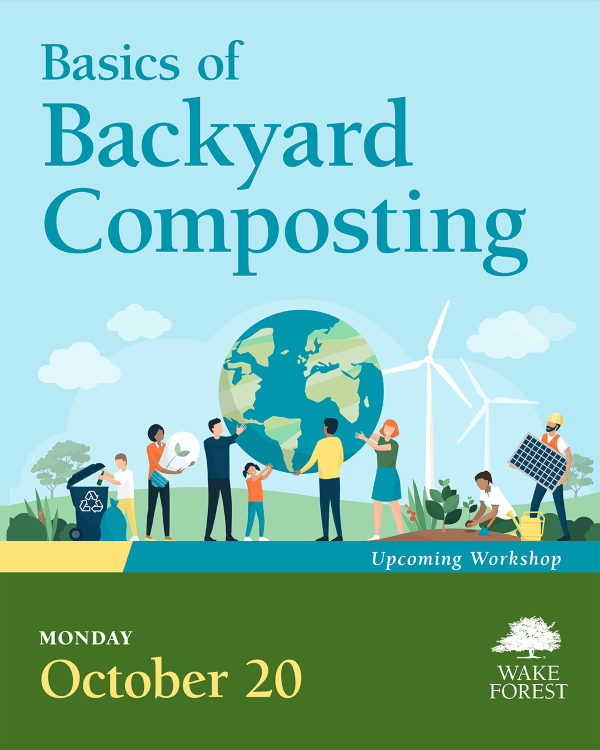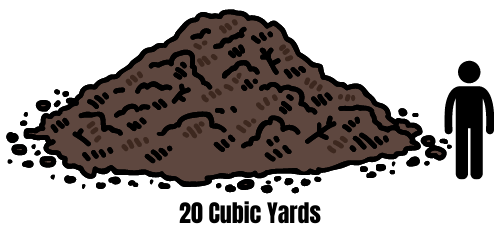 “Basics of Backyard Composting” workshop October 20
“Basics of Backyard Composting” workshop October 20
The Town of Wake Forest will host a “Basics of Backyard Composting” workshop on Monday, Oct. 20, from 5:45-6:45 p.m. at the Wake Forest Renaissance Centre, 405 S. Brooks St.
Geared for homeowners and led by a Wake County Master Gardner, the session will describe the basics on composting and explain how to compost in your own backyard.
The cost to participate is $5, and registration is required. The nominal fee will be donated to the Wake Forest Police Department Turkey Drive which helps provide Thanksgiving turkeys to needy families in our area.
Everyone who registers and attends the workshop will be entered in a drawing to win a free compost bin.
For more information, contact Sustainability Coordinator Jeanette Johnson at 919-435-9585.
Mulch & Wood Chips
 The Town of Wake Forest makes a variety of mulch and wood chips available for free to local community members upon request.
The Town of Wake Forest makes a variety of mulch and wood chips available for free to local community members upon request.
Mulch is available to local community members within 15 miles of Town limits.
- Due to the inconsistent colors, sizes, and types of trees and branches chipped and ground, the wood chips the Town provides are different from those you would expect to purchase at a home improvement store
- Each delivery is approximately 20 cubic yards (five pickup truck loads)
- The Town is not responsible for any damage to driveways, yards, or private property when delivery is made
- There is a waiting list for wood chips, and they will be delivered as soon as they are available. Additionally, the Town does not deliver on weekends or Town Holidays
NOTICE: Mulch is ONLY delivered in dump truck load quantities. No smaller quantity is delivered. Once delivered, the Town will not return to collect the mulch once it has been delivered.
Leaf Mulch
*Currently Unavailable*
Leaf mulch is the result of shredding loose leaves collected by the Town of Wake Forest. The leaves, over time, can turn from dark brown to black and have an earthy aroma and crumbly texture. Leaf mulch can be a soil conditioner. Instead of supplying the plants with nutrients like compost does, it can improve the soil structure. It can be mixed into your garden soil to increase water retention making it easily available for plants.
* Each delivery is approximately 20 cubic yards (five pickup truck loads). The Town is not responsible for any damage to driveways, yards, or private property when delivery is made.*
Wood Chips
Made from chipped or ground trees and branches, wood chips make an attractive and decorative border for paths, in planting beds, or around trees and shrubbery. (Please Note: Due to inconsistent colors, sizes and types of trees and branches chipped or ground, the wood chips the Town provides is different from the kind you would expect to purchase at a home improvement store.)
* Each delivery is approximately 20 cubic yards (five pickup truck loads). The Town is not responsible for any damage to driveways, yards, or private property when delivery is made.*
Applying Mulch
Spring and Fall are the best times of year to apply mulch. One cubic yard of mulch spread two inches thick will cover approximately 180 square feet of ground. Spread mulch evenly, but avoid mulching directly around stems and trunks of trees.
Additional Information
Mulch is most commonly used to top dress gardens and landscapes to provide a distinct boundary for landscaped and garden areas, to suppress weed growth without the use of chemicals and to help soil retain moisture. It can also be effective as a ground cover to help control erosion in certain circumstances. Ask your state or county erosion control inspector for assistance, or visit the North Carolina Compost Council.
Disclaimer
Each delivery is approximately 20 cubic yards (five pickup truck loads). The Town is not responsible for any damage to driveways, yards, or private property when delivery is made. The Town of Wake Forest cannot guarantee that these products do not contain weed seeds, organisms, metal or other contaminants. The Town is not responsible for any damage due to loading or delivery.
Try Composting
Compost is a dark, crumbly soil-like material that is an excellent natural soil additive. It can help transform heavy red clay or loose sand into rich fertile soil without the use of chemicals. To rejuvenate an impoverished soil or establish a new garden plot, apply 2 to 3 inches of compost, and dig it into the surface of the soil.
Many yard trimmings can be quickly composted at home and re-used as mulch. If you aren't already backyard composting and would like to learn how, follow the directions below.
How to Make Compost
- Start your compost with a 3-inch layer of coarse plant material, such as small twigs or chopped corn stalks. This will aid in aeration and drainage. On top of this, put a layer of plant and kitchen refuse, leaves, straw, weeds and waste from garden plants, husks, coffee grounds, filters, tea bags, crushed egg shells, vegetable wastes, canning wastes, hair trimmings, etc. If you’d like to compost food waste or kitchen scraps, you should have an enclosed compost bin. Don’t put meat, dairy, fish, poultry, oily foods, cooked foods or pet wastes in your compost; they create odor and attract digging animals. If you see pests around your compost, learn more about prevention.
- Add a layer of nitrogen-rich material. This can be fresh manure if available, fresh grass clippings (not too thick a layer, as they will mat), fresh hay or green weeds. Nitrogenous materials are necessary for the microorganisms to make proteins.
- To inoculate the compost pile, about 1 inch of soil should be added for each 6-inch layer of plant waste to supply microorganisms for the composting process, unless enough soil is included in the manure or on the roots of weeds and expired vegetable plants. If the waste materials are free of soil for the most part, a sprinkling of soil, a compost starter, or a layer of old compost or good gardening soil added to each layer will introduce necessary microorganisms. Repeat the layers of plant material and nitrogenous material as many times as needed to use all the plant refuse available. Keep the top of the pile lower in the center to cause water to move into the pile rather than run off.
- Water the pile as often as necessary to keep the contents moist, but not soaking wet. Within a few days, the pile should heat up significantly, to about 160 degrees Fahrenheit. This temperature will kill many weed seeds and harmful organisms and is a necessary stage in composting. If the pile fails to heat, it may lack nitrogen or moisture. The pile will also decrease in size after a few weeks if it’s composting properly. If you smell ammonia it may mean the pile is too tightly packed or it’s too wet (not enough air in the pile), so turn the heap, adding some coarser material, and start again.
- The pile should be forked over after about a month (two weeks if the material is shredded), putting the outside materials on the inside and vice versa to make sure everything gets broken down. Turn again five to six weeks later. The plant materials should decompose into good compost in about four to five months in warm weather but may take longer under cool or dry conditions. Composting may be completed in one to two months if the materials are shredded, kept moist and turned several times to provide good aeration. When compost is finished it will be black and crumbly, like good soil, with a pleasant, earthy smell.
Not Interested in Composting?
Mowing & Lawn Waste
Leave your grass clippings on your lawn! By leaving grass clippings on your lawn, you are returning much-needed moisture and nutrients to the soil. It will not contribute to excess thatch build up. If thatch is problem, you most likely are watering your lawn too much or utilizing too much fertilizer. Additionally, by leaving grass clippings on your lawn, you will save time and energy spent bagging your grass.
For a healthy lawn, cut often. Never cut off more than 1/3 of the grass height. Using a mulching lawn mower will also help break down the blades. Keep your blade sharp and dry. Alternate mowing direction will keep the grass from being pushed over in just one direction.
For more information on lawn care, view NC Cooperative Extension Lawn Care resources.
Limbs & Yard Waste
Friendly reminder that North Carolina has banned yard waste from landfills, so do not place yard waste in your trash cart.
If you're not interested in composting, consider researching low-maintenance lawn care ideas for the long-term. In the short-term, please hold on to your materials. We’ve seen an increased volume of waste from spring yard work but we encourage you to only perform yard work that is essential or of immediate need.

